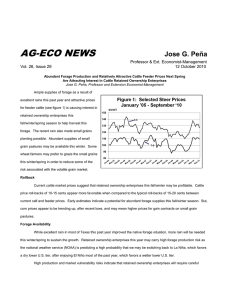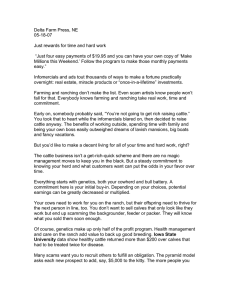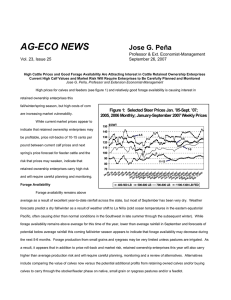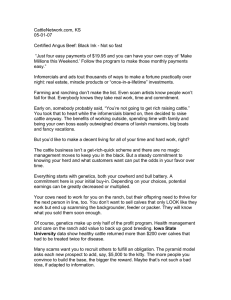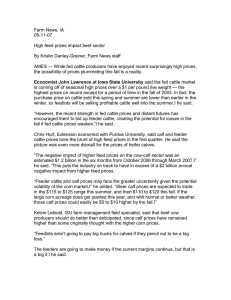AG-ECO NEWS Jose G. Peña
advertisement
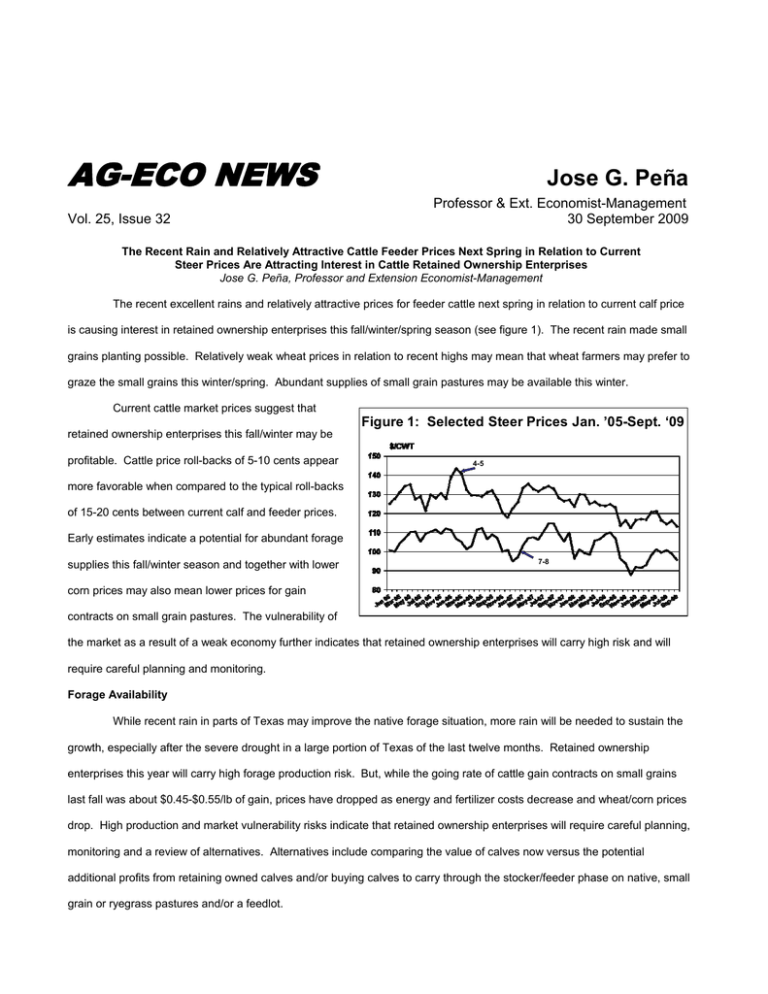
AG-ECO NEWS Vol. 25, Issue 32 Jose G. Peña Professor & Ext. Economist-Management 30 September 2009 The Recent Rain and Relatively Attractive Cattle Feeder Prices Next Spring in Relation to Current Steer Prices Are Attracting Interest in Cattle Retained Ownership Enterprises Jose G. Peña, Professor and Extension Economist-Management The recent excellent rains and relatively attractive prices for feeder cattle next spring in relation to current calf price is causing interest in retained ownership enterprises this fall/winter/spring season (see figure 1). The recent rain made small grains planting possible. Relatively weak wheat prices in relation to recent highs may mean that wheat farmers may prefer to graze the small grains this winter/spring. Abundant supplies of small grain pastures may be available this winter. Current cattle market prices suggest that Figure 1: Selected Steer Prices Jan. ’05-Sept. ‘09 retained ownership enterprises this fall/winter may be profitable. Cattle price roll-backs of 5-10 cents appear 4-5 more favorable when compared to the typical roll-backs of 15-20 cents between current calf and feeder prices. Early estimates indicate a potential for abundant forage supplies this fall/winter season and together with lower 7-8 corn prices may also mean lower prices for gain contracts on small grain pastures. The vulnerability of the market as a result of a weak economy further indicates that retained ownership enterprises will carry high risk and will require careful planning and monitoring. Forage Availability While recent rain in parts of Texas may improve the native forage situation, more rain will be needed to sustain the growth, especially after the severe drought in a large portion of Texas of the last twelve months. Retained ownership enterprises this year will carry high forage production risk. But, while the going rate of cattle gain contracts on small grains last fall was about $0.45-$0.55/lb of gain, prices have dropped as energy and fertilizer costs decrease and wheat/corn prices drop. High production and market vulnerability risks indicate that retained ownership enterprises will require careful planning, monitoring and a review of alternatives. Alternatives include comparing the value of calves now versus the potential additional profits from retaining owned calves and/or buying calves to carry through the stocker/feeder phase on native, small grain or ryegrass pastures and/or a feedlot. Lower Cattle Inventory While calf and feeder prices are relatively weak, due in part to a weak economy, supplies are down. Prices could improve as confidence in the economy is restored. The U.S. cattle inventory on July 1, 2009 decreased about 1.5 million head from July 1, 2008. The 2009 calf crop is estimated at 35.6 million head, down 513,000 head from a calf crop of 36.113 million in 2008 and down 1.76 million head from a calf crop of 37.361 million head in 2007. Feeder supplies will remain in short supply unless feeder cattle imports from Mexico increase. Scarce supplies of cattle will keep a base support for prices, especially for feeder cattle ready to enter feedlots as feedlots are operating below capacity. USDA's September 18, 2009 Cattle on Feed report indicated an inventory of 9.88 million head on feed on September 1, 2009, down 1.2 percent from 9.997 million head on September 1, 2008 and down 4.1 percent from two years ago. Cattle marketings as of the end of August '09 were down 4.1 percent from a year ago to the lowest fed cattle marketing’s since the series began in 1996. Supplies of Competitive Meats Down Meanwhile, meat supplies are down but relatively abundant, providing consumers a wide variety of choices. USDA’s September 11, 2009 estimate of red meat production for 2009 (beef, pork, veal, lamb and mutton) at 49.1 billion pounds was down 2.2 percent from 50.2 billion pounds produced last year. Poultry production at 41.9 billion pounds was down 4.1 percent from 43.7 billion pounds produced last year. The September ‘09 estimate of this year’s beef production at 25.82 billion pounds was down 2.8 percent from 26.561 billion pounds produced last year. The average live weight for cattle slaughtered was 1,293 pounds, up 9 pounds from average slaughter weights of 1,284 pounds a year ago. Feedgrain Prices Prices for corn have weakened significantly from last year’s record highs as a large production estimate, lower exports and indications of a weakened economy impact prices. USDA=s September 11, 2009 corn production forecast for 2009 at 12.954 billion bushels is up 193 million bushels (1.5%) from last month’s estimate of 12.761 billion bushels and just 84 million bushels below 2007’s record crop of 13.038 billion bushels. The national average yield was projected at a record 161.9 bushels per acre. With total use projected at 13.025 billion bushels, use will exceed the production estimate. Ending stocks at 1.635 billion bushels are estimated to decrease by 30 million bushels from beginning stocks of about 1.695, but prices remain weak. Futures prices on the Chicago Board of Trade (CBOT) were trading from $3.49/bu. (December ’09) to $3.84/bu. (December ‘10). USDA projects the 2009/10 marketing-year average farm price lower at $3.05 to $3.65 per bushel, compared with $3.10 to $3.90 per bushel last month. The price of cost of gain contracts on winter forages varies widely depending on the quality of the forage. Weak wheat and corn prices and a relatively large estimate of forage production this winter has also weakened cost of gain prices. Prices vary from a low of about $0.30/lb of gain to as high as $0.50/lb, depending on the forage quality and the services provided. Stockers Retained Ownership Profit Margin A retained ownership enterprise and/or buying stockers this fall will provide an opportunity to add value to the calves through additional gain from relatively manageable forage and/or cost of gain through a feedlot (in relation to market prices). The enterprise would require additional investments in terms of the current value of calves and the potential cost of the gain. With four to five weight #1 and #2 grade calves trading in the $1.03-1.10/lb range compared to cattle-feeder futures contracts for January ‘10 through August ‘10 delivery trading at about $0.97-$0.99/lb, in the Chicago Mercantile Exchange, price roll-backs will continue to play an important role in a retained ownership enterprise. If good quality forage is available at affordable prices, stocker retained ownership enterprises this winter could be profitable if properly planned, managed and monitored. The feedlot option, while probably less risky from a production viewpoint, may carry higher financial risk. The accumulated cost of the calves, their current market value and the owner’s financial situation should serve as the benchmark to evaluate the profit potential and risk associated with a retained ownership enterprise this coming winter. Keep in mind that retaining ownership will increase management and decision-making requirements. More capital will be required for the additional production expenses and annual cash flows will change because retaining ownership will delay income and add production costs. Table 1 provides an estimate of TABLE 1: RETAINED OWNERSHIP PROFIT MARGIN PER STOCKER ON SMALL GRAIN PASTURE ASSUMPTIONS: potential profits for a 450 pound steer with a current value of $1.04/lb, by varying the cost of gain and the sale price next spring (150 days on small grain pasture). If, for example, the total cost of gain averages $0.43/lb, at 1.7 lb average daily gain (adg) for 150 days, and the steers are sold at the current futures price quote for April ‘10 delivery ($0.99/lb), a rancher could average Cost of Gain $0.35 $0.36 $0.37 $0.38 $0.39 $0.40 $0.41 $0.42 $0.43 $0.44 $0.45 $0.46 $0.47 $0.48 $0.49 $0.50 $0.95 $86 $84 $81 $79 $76 $73 $71 $68 $66 $63 $61 $58 $55 $53 $50 $48 $0.96 $93 $91 $88 $86 $83 $80 $78 $75 $73 $70 $67 $65 $62 $60 $57 $55 450 $1.04 7.5% 1.7 150 1.5% $0.97 $100 $98 $95 $93 $90 $87 $85 $82 $80 $77 $74 $72 $69 $67 $64 $61 Initial Steer Weight, Lbs Current Steer Value, Per Lb Annual Percentage Rate (APR) Average Daily Gain, Lbs Days on Pasture Death Loss Sale Price $0.98 $0.99 $1.00 $1.01 $107 $114 $121 $128 $105 $112 $119 $126 $102 $109 $116 $123 $99 $106 $113 $120 $97 $104 $111 $118 $94 $101 $108 $115 $92 $99 $106 $113 $89 $96 $103 $110 $87 $93 $100 $107 $84 $91 $98 $105 $81 $88 $95 $102 $79 $86 $93 $100 $76 $83 $90 $97 $74 $81 $87 $94 $71 $78 $85 $92 $68 $75 $82 $89 $1.02 $135 $132 $130 $127 $125 $122 $120 $117 $114 $112 $109 $107 $104 $101 $99 $96 $1.03 $142 $139 $137 $134 $132 $129 $126 $124 $121 $119 $116 $113 $111 $108 $106 $103 $1.04 $149 $146 $144 $141 $139 $136 $133 $131 $128 $126 $123 $120 $118 $115 $113 $110 $1.05 $156 $153 $151 $148 $146 $143 $140 $138 $135 $133 $130 $127 $125 $122 $120 $117 about $93/head in profits. Similar profit opportunities may not work in native pasture since the rate of gain and the days left before a killing frost may be limited. Price risk management Price risk management would be an essential part of a five month retained ownership commitment on small grains. A price base for the steers next spring could be established by selling a feeder cattle-futures contract or buying a put option (option to sell a futures contract) contract. A put option contract with a strike price at $0.99/lb (Tuesday, September 29, 2009) with a May ‘10 delivery date would cost about 4.2 cents a pound. This means that after option costs and commissions are deducted, a price base of about $0.95/lb could be established with a May ‘10 put options contract. Using the same basic assumptions as above, this alternative would reduce profits to about $66/head. NOTE: In terms of capital costs and managing risks, this example would require a total investment of about $580/steer (450 lb x $1.04 plus 255 lbs gained x $0.43) compared to an average investment of about $468/steer. In other words, the investor is placing about $112 of addition capital, at risk through this venture. As a result, lower price roll-backs and potentially lower cost of gain contracts on winter small grain pastures but higher forage production risk and a potential for improved prices for calves indicates that enterprises will require very careful planning and monitoring. Any pricing alternatives that are utilized should provide a floor price yet keep any price improvement open. These alternatives include buying a put option and/or using a minimum price contract. Appreciation is expressed to Stan Bevers, Professor and Extension Economist-Mgmt. for his contribution to review of this article. .
